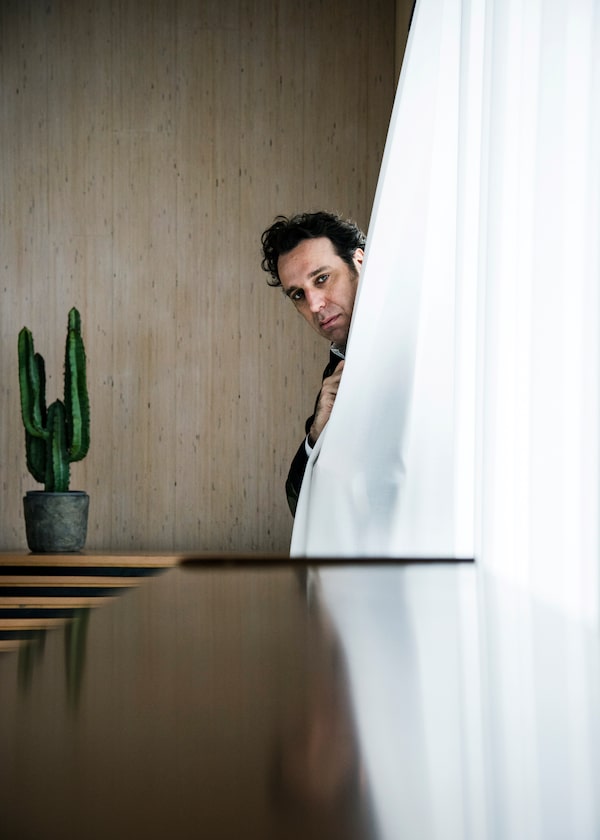
In the spring of 2009, Chilly Gonzales broke the Guinness world record for the longest solo concert when he performed for 27 hours, three minutes and 44 seconds at the Ciné 13 Theatre in Paris.Alexandre Isard/Supplied
With the series Applause, Please, The Globe and Mail recognizes the efforts of dedicated citizens and those behind the scenes who make a difference in arts and cultural programs and institutions.
In the spring of 2009, Chilly Gonzales broke the Guinness world record for the longest solo concert when he performed for 27 hours, three minutes and 44 seconds at the Ciné 13 Theatre in Paris. At his upright piano, the Grammy-winning Canadian expat and iconoclast played more than 200 songs. The set list covered everyone from Beethoven to Britney Spears to the Bee Gees (but did not include the 1959 instrumental hit by Santo & Johnny, Sleep Walk).
Suffice to say that Gonzales (known for his collaborations with such artists as Feist, Drake and Daft Punk) is unusually willing and able to go the distance. And that he is a fierce proponent of live performane.
“The only way to legitimately build your audience, in a meaningful, long-term way, is to get in front of them,” the composer-pianist says from his home in Cologne, Germany. “I truly believe that. In fact, it is the prime directive of the Gonzervatory.”
The Gonzervatory, which takes its name from Gonzales’s nickname “Gonzo,” is an annual 10-day performance workshop he created with the hope of spawning a new pedagogy of musical training. Last year, Gonzales invited seven young musicians to a Paris loft for a “crazy” schooling in composing, performance, audience psychology and what he calls “musical humanism,” which refers to the common ground of music – free of racial, geographic and any other barriers. That debut class included a Texas rapper, a jazz saxophonist from Ukraine, a Chilean art punk, a Mexican singer-songwriter and a multi-instrumentalist from rural Italy.
This fall, the travelling Gonzervatory will happen in Cologne. Aspiring musicians 18 years of age or older have until May 1 to apply for this year’s pressurized adventure in beats, melodies and self-assurance.
The whole thing is something of an experiment – a journey into the unknown, according to the Gonzervatory website, “with all its inevitable struggles and triumphs.” Although the Montreal-born Gonzales has researched the educational methods and business acumen of Maria Montessori, Waldorf education founder Rudolf Steiner and Pilates inventor Joseph Pilates, he admits his school is something of a work in progress.
"It’s a long-term, slow-burn project,“ says Gonzales, who previously published Re-Introduction Etudes, a book of piano pieces aimed at bringing lapsed amateur pianists back to the land of black and white keys. "It takes confidence to admit to people that you’re not exactly sure where you’re going.”

The end goal for Gonzales? 'I’m on the hunt for a practical design of exercises where I can improve people musically.'Alexandre Isard
Undeniably. So, how does Gonzales recruit elite students from around the world to participate (as guinea pigs, essentially) in an untried method of training?
“Three words,” says the audacious producer-musician, who once engaged French pianist and instructor Jean-François Zygel in a public piano duel. “All expenses paid."
Indeed, the Gonzervatory is free to the students, self-financed by Gonzales to the tune of approximately €150,000 ($225,000) a season. He has no sponsors, but does rely on "fellow travellers” and “true believers” who provide reduced rates for such things as studio space and performance halls (for the session-ending concert).
The end goal for Gonzales? “I’m on the hunt for a practical design of exercises where I can improve people musically. I want to design a scalable system where people could understand the benefits of trusting their first instincts and remove their tendency to overthink what they’re doing.”
To achieve that, Gonzervatory exercises involve tight time constraints, collaborative settings and situations which force the students to make unfamiliar aesthetic choices. If there is a model he’s attempting to follow, Gonzales himself embodies it. He wrote down 40 or 50 aspects of his own musical development, for the purpose of reverse engineering the steps that made him who he is, harmonically speaking, today. As he says, “I am patient zero of the Gonzervatory."
By Gonzales’s own estimate, his new method may take five to 10 years to perfect. The hope is for a system that can be widely instituted, without necessarily his personal involvement.
It is a nervy undertaking, but no one should underestimate him. Remember that in the late 1990s Gonzales immigrated to Europe after his band Son was dropped by Warner Music Canada. He reinvented himself. Still is reinventing. As he purportedly said before his piano brawl with Zygel, “Sometimes winning is just showing the opponent you’re ready to go farther than them."
Gonzales’s lengths are greater than most.
 Brad Wheeler
Brad Wheeler